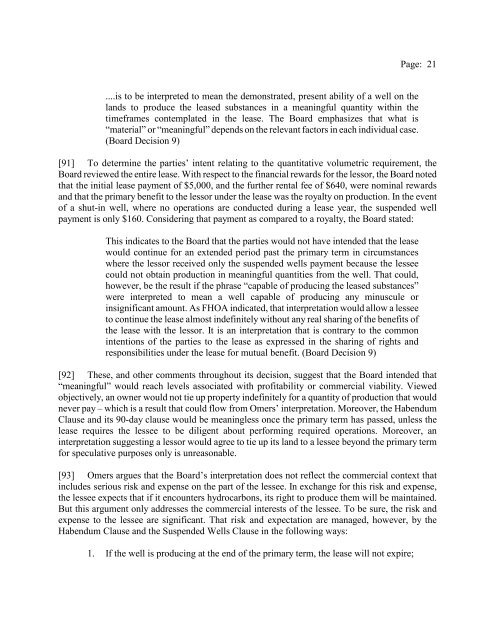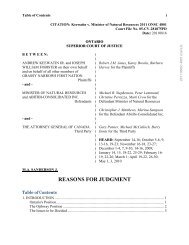Omers Energy Inc. v. Alberta (Energy Resources Conservation Board)
Omers Energy Inc. v. Alberta (Energy Resources Conservation Board)
Omers Energy Inc. v. Alberta (Energy Resources Conservation Board)
- No tags were found...
Create successful ePaper yourself
Turn your PDF publications into a flip-book with our unique Google optimized e-Paper software.
Page: 21....is to be interpreted to mean the demonstrated, present ability of a well on thelands to produce the leased substances in a meaningful quantity within thetimeframes contemplated in the lease. The <strong>Board</strong> emphasizes that what is“material” or “meaningful” depends on the relevant factors in each individual case.(<strong>Board</strong> Decision 9)[91] To determine the parties’ intent relating to the quantitative volumetric requirement, the<strong>Board</strong> reviewed the entire lease. With respect to the financial rewards for the lessor, the <strong>Board</strong> notedthat the initial lease payment of $5,000, and the further rental fee of $640, were nominal rewardsand that the primary benefit to the lessor under the lease was the royalty on production. In the eventof a shut-in well, where no operations are conducted during a lease year, the suspended wellpayment is only $160. Considering that payment as compared to a royalty, the <strong>Board</strong> stated:This indicates to the <strong>Board</strong> that the parties would not have intended that the leasewould continue for an extended period past the primary term in circumstanceswhere the lessor received only the suspended wells payment because the lesseecould not obtain production in meaningful quantities from the well. That could,however, be the result if the phrase “capable of producing the leased substances”were interpreted to mean a well capable of producing any minuscule orinsignificant amount. As FHOA indicated, that interpretation would allow a lesseeto continue the lease almost indefinitely without any real sharing of the benefits ofthe lease with the lessor. It is an interpretation that is contrary to the commonintentions of the parties to the lease as expressed in the sharing of rights andresponsibilities under the lease for mutual benefit. (<strong>Board</strong> Decision 9)[92] These, and other comments throughout its decision, suggest that the <strong>Board</strong> intended that“meaningful” would reach levels associated with profitability or commercial viability. Viewedobjectively, an owner would not tie up property indefinitely for a quantity of production that wouldnever pay – which is a result that could flow from <strong>Omers</strong>’ interpretation. Moreover, the HabendumClause and its 90-day clause would be meaningless once the primary term has passed, unless thelease requires the lessee to be diligent about performing required operations. Moreover, aninterpretation suggesting a lessor would agree to tie up its land to a lessee beyond the primary termfor speculative purposes only is unreasonable.[93] <strong>Omers</strong> argues that the <strong>Board</strong>’s interpretation does not reflect the commercial context thatincludes serious risk and expense on the part of the lessee. In exchange for this risk and expense,the lessee expects that if it encounters hydrocarbons, its right to produce them will be maintained.But this argument only addresses the commercial interests of the lessee. To be sure, the risk andexpense to the lessee are significant. That risk and expectation are managed, however, by theHabendum Clause and the Suspended Wells Clause in the following ways:1. If the well is producing at the end of the primary term, the lease will not expire;
















